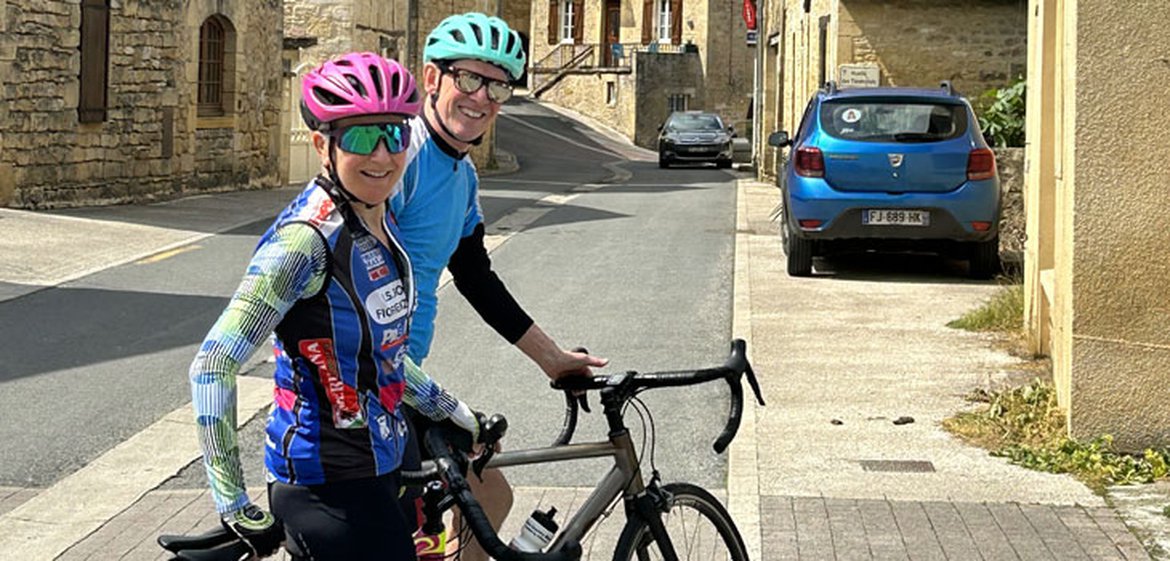Going the Distance
June 22, 2023

Pedalling through the French countryside is a lovely way to spend your days.
Especially in the southwestern departments of the Lot and the Dordogne.
Yes, the more popular Provence has its lavender fields, its vineyards and olive groves and, for any cyclist keen on proving their mettle, the daunting Mont Ventoux.
But for sheer “beauty and seduction” (to borrow the actual name of a salon in Gourdon, the Occitanie town where we usually stay), it’s hard to beat the lovely Lot and the delightful Dordogne.
Do you fancy a vast network of quiet country roads, roads that anywhere else wouldn’t even appear on a map? Lush green forests? Winding, wending rivers? Charming little villages dotted with centuries-old stone houses the colour of honey? And doable climbs – usually 2-4 kilometers at a reasonable pitch?
If so, then get yourself to the Lot and Dordogne post haste, for this lesser known area is a cyclist’s paradise.
On this latest trip, my partner, Richard, and I cycled almost every day for three weeks. Add to that a week in Riccione, Italy at the excellent Belvedere Bike Hotel (which offers daily guided rides, delicious meals, local wine, and nightly laundry service), and we managed to rack up a lot of kilometers on the bikes.
Over 1200, in fact.
Hmmm … all very nice, I hear you saying …. but how far is 1200 kilometers exactly?
Well, if you’ve ever driven across Canada, you’ll know that 1200 clicks is just under the distance from Toronto to Halifax. Or the distance from Toronto to Kingston and back again—twice.
If you’re a runner, 1200 kilometers is like running 120 10ks. Or 28 marathons. (I don’t recommend either, at least not consecutively.)
And if you’re a fan of the Tour de France, arguably the world’s most difficult and most beautiful sporting event, you’ll know that 1200 kilometers is just under one third of the total those lean, mean pros cover in just 21 days. Makes our effort seem like a warmup, doesn’t it?
The point is, on their own, numbers can often seem meaningless. For many of us, a number only makes sense, only becomes real, when we have some context or some way of relating it to something we already know.
In my work writing and editing sustainability reports, “translating” numbers so different audiences can understood them is crucial.
Thus, when an organization wants to explain how much energy it saved the previous year, they don’t simply talk about “gigawatts.” Instead they give the number context by saying, for example, “that’s enough energy to power about 750,000 homes for one year.”
Likewise, if an organization claims to have saved 100 million litres of water, that number is relatively meaningless until you understand “that’s the equivalent of running your kitchen tap on full for 180,500 hours or 7,500 days!”
Doing the math, and giving a number context, is just one of the many ways to make a number make sense. In her monthly newsletter, Wordnerdery, Sue Horner shares others:
- make a number—whether large or small—understandable by comparing it to something known
- make the number relatable (especially helpful when you’re talking about time)
- find the story
- use analogies
- supplement with charts or graphs
- don’t use numbers at all (how positively radical!); and, of course
- use plain language (!!!)
Sue has written several articles on communicating numbers, and in the process, she’s collected an excellent set of examples drawn from the public domain. So, for all your number needs, head on over to Wordnerdery and have a look for yourself.
To get you started, here are three of my favourite articles:
Five ways to help make numbers make sense
How big are bears? Perspective makes it plain
Eight ways to make numbers meaningful
And while you’re busy learning from Sue, I’ll be planning my next cycling trip to France. Bring on the kilometers!
Remember this: Numbers are like a foreign language. Most times, you’ll need to translate them for your audience. Try adding context or a story, comparing or relating the number to something known, or supplementing with a chart or graph.
